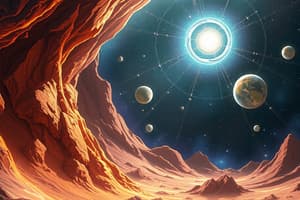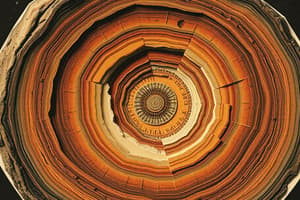Podcast
Questions and Answers
What primarily determines the composition of the Earth's mantle?
What primarily determines the composition of the Earth's mantle?
- The magnetic properties of the surface.
- The types of minerals in peridotite. (correct)
- The impact of large meteorites.
- The presence of water in the mantle.
How is heat primarily transferred from the Earth's core to the mantle?
How is heat primarily transferred from the Earth's core to the mantle?
- Via underground rivers of magma.
- By conduction and convection. (correct)
- Through radiation from surface layers.
- Through magnetic field interactions.
What is the main reason the mantle is considered to be extremely hot?
What is the main reason the mantle is considered to be extremely hot?
- The heat flows from the mantle's surface.
- Heat from radioactive decay occurs in the mantle.
- Heat conducted from the core is significant. (correct)
- It is affected by solar radiation heat.
What happens to the mantle material as it heats up near the core?
What happens to the mantle material as it heats up near the core?
What confirms the liquid state of the outer core?
What confirms the liquid state of the outer core?
What percentage of the Earth's core is composed of iron?
What percentage of the Earth's core is composed of iron?
What causes Earth's magnetic field?
What causes Earth's magnetic field?
What is the primary way in which mantle convection is similar to convection in water?
What is the primary way in which mantle convection is similar to convection in water?
What characterizes divergent plate boundaries?
What characterizes divergent plate boundaries?
What is the result of oceanic-continental convergence?
What is the result of oceanic-continental convergence?
Which of the following is a result of transform fault boundaries?
Which of the following is a result of transform fault boundaries?
Which phenomenon is commonly associated with oceanic-oceanic convergence?
Which phenomenon is commonly associated with oceanic-oceanic convergence?
What do transform faults primarily connect?
What do transform faults primarily connect?
Which of the following supports the theory of plate tectonics?
Which of the following supports the theory of plate tectonics?
What is the primary effect of the lithosphere being broken into plates?
What is the primary effect of the lithosphere being broken into plates?
What geological feature can form as a result of continental-continental convergence?
What geological feature can form as a result of continental-continental convergence?
What significant environmental change occurred at the end of the Palaeozoic era?
What significant environmental change occurred at the end of the Palaeozoic era?
During which period did dinosaurs first appear?
During which period did dinosaurs first appear?
Which plant groups became dominant during the Mesozoic era?
Which plant groups became dominant during the Mesozoic era?
What geological event marked the transition from the Palaeozoic to the Mesozoic era?
What geological event marked the transition from the Palaeozoic to the Mesozoic era?
What is one of the notable features of the Jurassic Period?
What is one of the notable features of the Jurassic Period?
Why did many forms of life, including dinosaurs, abruptly disappear at the end of the Cretaceous Period?
Why did many forms of life, including dinosaurs, abruptly disappear at the end of the Cretaceous Period?
What did marine reptiles like ichthyosaurs and plesiosaurs do during the Jurassic Period?
What did marine reptiles like ichthyosaurs and plesiosaurs do during the Jurassic Period?
What event led to the formation of the Appalachians during the Permian Period?
What event led to the formation of the Appalachians during the Permian Period?
What is the primary reason that the outer core remains liquid?
What is the primary reason that the outer core remains liquid?
What marked the beginning of Earth's atmosphere formation?
What marked the beginning of Earth's atmosphere formation?
During which eons did the Precambrian span?
During which eons did the Precambrian span?
What process contributed to the formation of Earth's initial crust?
What process contributed to the formation of Earth's initial crust?
Which of the following best describes cratons?
Which of the following best describes cratons?
What significant event occurred around 3.5 billion years ago?
What significant event occurred around 3.5 billion years ago?
What was a major consequence of the decay of radioactive elements in the early Earth?
What was a major consequence of the decay of radioactive elements in the early Earth?
What is referred to as the most recent supercontinent?
What is referred to as the most recent supercontinent?
What major change occurred in plant life during the Cretaceous period?
What major change occurred in plant life during the Cretaceous period?
During which epoch did new mammal groups such as small, horse-like animals and whales develop?
During which epoch did new mammal groups such as small, horse-like animals and whales develop?
What significant land connection was established for North America during the Tertiary period?
What significant land connection was established for North America during the Tertiary period?
Which period is known as the age of mammals?
Which period is known as the age of mammals?
What geological principle states that current processes have operated similarly through time?
What geological principle states that current processes have operated similarly through time?
Which period did modern humans (Homo sapiens) first appear?
Which period did modern humans (Homo sapiens) first appear?
What event allowed humans to migrate to the New World?
What event allowed humans to migrate to the New World?
What was a major consequence of the increasing prominence of grasses during the Tertiary period?
What was a major consequence of the increasing prominence of grasses during the Tertiary period?
Flashcards are hidden until you start studying
Study Notes
Composition and Properties of the Mantle
- The mantle consists mainly of ultramafic rock peridotite, characterized by high iron and magnesium content.
- Seismic waves, heat flow data, and meteorites provide evidence of the mantle's rocky nature.
- Heat within the mantle is transferred through conduction (solid materials) and convection (flowing materials).
- The mantle is heated primarily by conduction from the core and convection currents that arise from the heat at the core.
Convection Mechanism in the Mantle
- Convection currents in the mantle form as material near the core heats up, decreases in density, and rises.
- Once the material reaches the surface and spreads horizontally, it cools and eventually sinks back into the mantle.
- This cyclical movement contributes to mantle convection cells.
Structure and Composition of the Core
- The Earth's core is primarily metallic, composed of approximately 85% iron and 15% nickel.
- The core's metal composition is essential for Earth’s magnetic field, which wouldn't exist if the core were made of rock.
- S-waves cease to exist at the inner core, confirming the core's outer component is liquid, while the inner core is solid.
- Heat from the inner core prevents the outer core from solidifying and is generated by radioactive element decay.
Earth's Formation and Evolution
- Earth formed about 13.7 billion years ago from materials created during the Big Bang and elements from ancient stars.
- High-velocity impacts and radioactive decay increased Earth’s temperature, resulting in the melting of iron and nickel to form the core.
- The early atmosphere, formed through outgassing, was primarily water vapor and carbon dioxide.
Development of Earth's Early Environment
- The introduction of photosynthesizing bacteria around 3.5 billion years ago began the release of oxygen into the atmosphere.
- Oceans formed as water vapor condensed, with salinity resulting from volcanic activity and erosion.
- The Precambrian (spanning 4.6 billion to 542 million years ago) saw the creation of much of Earth's stable continental crust through volcanic activity and accretion.
Tectonic Plate Dynamics
- Earth's lithosphere is divided into tectonic plates that float on the weaker asthenosphere below.
- Divergent boundaries occur when plates move apart, leading to new seafloor at mid-ocean ridges.
- Convergent boundaries result in subduction zones, forming oceanic trenches and volcanic arcs like the Andes.
- Transform boundaries involve lateral movement of plates, exemplified by the San Andreas Fault.
Geological Time Periods
- Pangaea, the most recent supercontinent, formed during the Permian period, leading to significant evolutionary shifts.
- The Mesozoic era, or age of reptiles, was marked by the emergence of dinosaurs and other reptiles.
- The end of the Cretaceous period saw the extinction of dinosaurs and significant floral changes with the rise of angiosperms.
- The Cenozoic era, or age of mammals, experienced diversification in mammal species and the emergence of modern ecosystems.
Important Geological Principles
- The principle of uniformitarianism states that current geological processes are consistent with those that have occurred throughout Earth’s history.
Studying That Suits You
Use AI to generate personalized quizzes and flashcards to suit your learning preferences.




